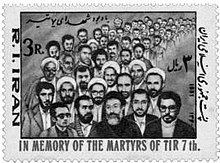Target IRP leaders Attack type Suicide attack | Start date June 28, 1981 Total number of deaths 72 | |
 | ||
Suspected perpetrator People's Mujahedin of Iran | ||
On 28 June 1981 (the 7th of Tir 1360 (Hafte Tir – هفت تیر) in the Iranian calendar), a powerful bomb went off at the headquarters of the Iran Islamic Republic Party (IRP) in Tehran, while a meeting of party leaders was in progress. Seventy-three leading officials of the Islamic Republic were killed, including Chief Justice Ayatollah Mohammad Beheshti (who was the second-most powerful figure in the revolution after Ayatollah Khomeini at the time). The People's Mujahedin of Iran or Mujahideen al-Khalq is thought to have been responsible for the attack.
Contents
Background
Following the Iranian revolution, the newly established theocratic government of Ayatollah Khomeini in Iran consolidated its power by eliminating opposition to their rule, including the Islamic socialist organisation known as People's Mujahedin of Iran (also PMOI or MEK). Ayatollah Ruhollah Khomeini attacked the PMOI as elteqati (eclectic), contaminated with Gharbzadegi ("the Western plague"), and as monafeqin (hypocrites) and kafer (unbelievers). In retaliation, in February 1980 concentrated attacks by hezbollahi began in the meeting places, bookstores, newsstands of the Mujahideen. Hundreds of PMOI supporters and members were killed from 1979 to 1981, and some 3,000 were arrested. Ultimately, the organization called for a massive demonstration under the banner of Islam on June 20, 1981 to protest Iran's new leadership which was also attacked.
Events
On 28 June 1981 the Hafte tir bombing occurred killing the chief justice and party secretary Ayatollah Mohammad Beheshti, four cabinet ministers (Health, transport, telecommunications and energy ministers), twenty-seven members of the Majlis, including Mohammad Montazeri, and several other government officials.
Khomeini accused the PMOI to be responsible and, according to BBC journalist Baqer Moin, the Mujahedin were "generally perceived as the culprits" for the bombing in Iran. The Mujahedin never publicly confirmed or denied any responsibility for the deed, but stated the attack was ‘a natural and necessary reaction to the regime's atrocities.’ The bomber was identified as a young student and Mujahedin operative by the name of Mohammad Reza Kolahi, who had secured a job in the building disguised as a sound engineer. He was never found and no group or person has ever accepted the responsibility or been put on trial for this bombing. This has led to conspiracy theories by some who claim that the bombing was motivated by an internal power struggle and perpetrated by a faction within the Iranian ruling party. IRP was eventually dissolved because of these polarizations. Another conspiracy theory maintains that only state-backed organizations could ever acquire such a powerful bomb and points the finger at Israel's Mossad.
Assassinations of "leading officials and active supporters of the regime by the Mujahedin were to continue for the next year or two," though they failed to overthrow the government. Two months after Hafte tir on August 30, another bomb was detonated killing the President Rajai and Premier Mohammad Javad Bahonar. An active member of the Mujahedin, Massoud Kashmiri, was identified as the perpetrator, and according to reports came close to killing the entire government including Khomeini. The reaction following both bombings was intense with many arrests and executions of Mujahedin and other leftist groups.
To commemorate the event several public places in Iran including major squares in Tehran and other cities are named “Hafte Tir”.
